
1. Introduction to Bile Duct Cancer (Cholangiocarcinoma)
Bile duct cancer refers to a group of cancers that originate in the bile ducts. These ducts are part of the biliary system, which is responsible for transporting bile, a fluid that helps digest fats, from the liver to the small intestine. Cholangiocarcinoma is classified based on the location of the tumor in the biliary system:
- Intrahepatic Cholangiocarcinoma: Cancer that begins inside the liver.
- Perihilar Cholangiocarcinoma: Cancer located at the junction of the left and right bile ducts, near the liver.
- Distal Cholangiocarcinoma: Cancer that occurs in the bile ducts near the small intestine.
Understanding the different types of bile duct cancer is important as they often have different symptoms, treatment options, and prognoses. However, one thing they all have in common is the challenge of being diagnosed early.
2. What Causes Bile Duct Cancer?

The exact cause of bile duct cancer remains unclear, but several risk factors are associated with the development of this disease. These factors often involve underlying medical conditions, genetic predispositions, or environmental exposures. Bile duct cancer typically occurs when mutations or genetic changes disrupt the normal function of cells in the bile ducts, leading them to grow uncontrollably.
2.1. Chronic Liver Disease and Cirrhosis
One of the most significant risk factors for developing bile duct cancer is the presence of chronic liver diseases, particularly cirrhosis. Cirrhosis refers to severe scarring of the liver tissue, often caused by long-term liver damage due to factors such as viral infections (e.g., hepatitis B or C), excessive alcohol consumption, or non-alcoholic fatty liver disease (NAFLD).
- Chronic Inflammation: The persistent inflammation and scarring associated with cirrhosis can increase the risk of abnormal cell growth in the bile ducts, eventually leading to cancer.
- Hepatitis: Chronic infection with hepatitis B or C increases the risk of cirrhosis, which in turn raises the risk of developing bile duct cancer.
2.2. Primary Sclerosing Cholangitis (PSC)
Primary sclerosing cholangitis (PSC) is a rare, chronic disease that causes inflammation and scarring of the bile ducts. This condition is strongly associated with the development of cholangiocarcinoma, particularly in individuals with a history of inflammatory bowel disease (IBD), such as ulcerative colitis.
- PSC and Bile Duct Cancer Risk: Approximately 10-20% of people with PSC will eventually develop cholangiocarcinoma. The risk increases with the duration of PSC.
2.3. Bile Duct Infections (Cholangitis)
Chronic infections of the bile ducts can also contribute to an increased risk of bile duct cancer. These infections can be caused by bacterial or parasitic organisms that invade the biliary system, leading to inflammation and an elevated likelihood of cancer development.
- Liver Flukes: In some parts of the world, particularly Southeast Asia, infection with liver flukes (parasitic worms) is a known risk factor for cholangiocarcinoma. The flukes can cause inflammation and scarring in the bile ducts, which increases cancer risk.
3. Who is More Likely to Develop Bile Duct Cancer?
Certain populations are more susceptible to bile duct cancer due to various medical conditions, lifestyle factors, and genetic predispositions. Understanding these risk groups can help identify individuals at higher risk, making early detection and prevention possible.

3.1. Age and Gender
Bile duct cancer can affect individuals at any age, but it is more commonly diagnosed in older adults. The average age of diagnosis is typically around 65 years. The risk of cholangiocarcinoma increases with age, and the condition is rare in individuals under 40.
- Gender: Cholangiocarcinoma tends to be more common in men than in women. However, the gender disparity may vary depending on the specific type of bile duct cancer and the underlying conditions of the individual.
3.2. People with Chronic Liver Disease
Individuals who have chronic liver disease, especially cirrhosis, are at a significantly higher risk of developing bile duct cancer. This group includes individuals with:
- Chronic Hepatitis B or C: As mentioned earlier, viral hepatitis can cause liver damage, cirrhosis, and ultimately increase the risk of bile duct cancer.
- Non-Alcoholic Fatty Liver Disease (NAFLD): NAFLD is associated with obesity and type 2 diabetes, and it can eventually lead to cirrhosis, increasing the risk of cholangiocarcinoma.
3.3. Patients with Primary Sclerosing Cholangitis (PSC)
Individuals with PSC are at a particularly high risk of developing bile duct cancer. PSC is a rare, progressive disease that causes inflammation and scarring in the bile ducts. While the condition is uncommon, it is strongly associated with cholangiocarcinoma.
- Association with Inflammatory Bowel Disease (IBD): People with IBD, particularly ulcerative colitis, are more likely to develop PSC and, subsequently, bile duct cancer. Those with long-standing IBD have an elevated risk of both conditions.
3.4. Genetic Factors and Family History
While genetic mutations are not a common cause of bile duct cancer, certain inherited genetic conditions can increase the risk. These include:
- Familial Cholangiocarcinoma: Some families may have a higher incidence of bile duct cancer, suggesting a genetic predisposition. However, familial cholangiocarcinoma is extremely rare.
- Hereditary Conditions: Conditions such as Lynch syndrome, which predispose individuals to various cancers, can increase the risk of cholangiocarcinoma.
Individuals with a family history of bile duct cancer should discuss genetic testing and surveillance options with their healthcare provider.
3.5. Geographic and Environmental Factors
Certain regions of the world have higher rates of bile duct cancer. This is due to environmental exposures, lifestyle factors, and the prevalence of infectious diseases.
- Southeast Asia: In countries like Thailand and Laos, the incidence of cholangiocarcinoma is much higher due to the prevalence of liver fluke infections, which significantly increase the risk of bile duct cancer.
- Chemical Exposures: Chronic exposure to certain chemicals, such as those used in industrial processes, may increase the risk of cholangiocarcinoma. These chemicals include polychlorinated biphenyls (PCBs) and asbestos.
4. Prevention and Early Detection
Although the exact cause of bile duct cancer is not well understood, there are steps individuals at higher risk can take to prevent or detect the disease early.
4.1. Managing Chronic Liver Diseases
For individuals with chronic liver diseases such as cirrhosis, hepatitis B or C, and NAFLD, regular monitoring and management are essential. This includes:
- Vaccination: Vaccination against hepatitis B and regular screenings for hepatitis C can reduce the risk of liver damage and bile duct cancer.
- Antiviral Treatments: For individuals with chronic viral hepatitis, antiviral treatments can reduce liver inflammation and decrease the likelihood of cirrhosis and cancer development.
4.2. Surveillance for At-Risk Individuals
For individuals with PSC, IBD, or a family history of bile duct cancer, regular screening is recommended. This may include:
- Imaging Tests: Ultrasounds, MRIs, or CT scans can help detect early signs of bile duct cancer.
- Endoscopic Surveillance: For those with PSC, endoscopic retrograde cholangiopancreatography (ERCP) can be used to visualize the bile ducts and detect any abnormalities.
4.3. Lifestyle Modifications
- Healthy Diet and Exercise: Maintaining a healthy weight, avoiding excessive alcohol consumption, and eating a balanced diet can help reduce the risk of developing chronic liver disease, which in turn lowers the risk of bile duct cancer.
- Avoiding Toxic Chemicals: Limiting exposure to harmful chemicals, especially for those working in industries involving asbestos or certain solvents, can reduce the risk of cholangiocarcinoma.
Bile duct cancer (cholangiocarcinoma) is a rare and aggressive form of cancer that affects the bile ducts. While the exact cause remains unclear, several risk factors contribute to the development of this disease. Individuals with chronic liver disease, primary sclerosing cholangitis, or certain genetic conditions are at higher risk. Early detection through regular screening and lifestyle changes can help reduce the risk or catch the disease at an earlier, more treatable stage.
By understanding the risk factors and taking preventive measures, those at higher risk can improve their chances of early diagnosis and better outcomes. Healthcare providers play a critical role in educating at-risk populations and encouraging timely medical intervention.


